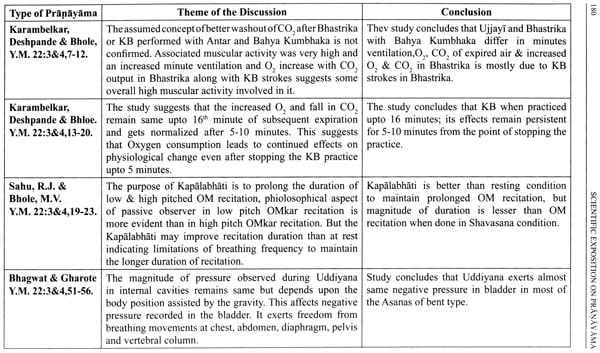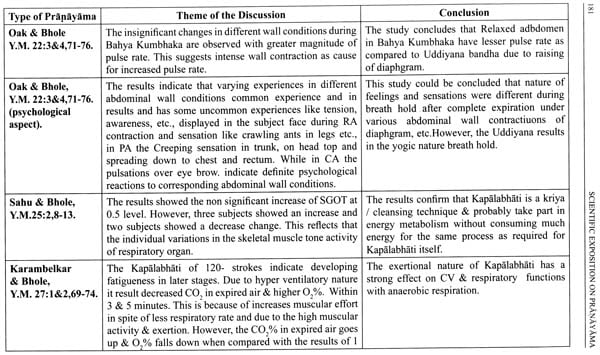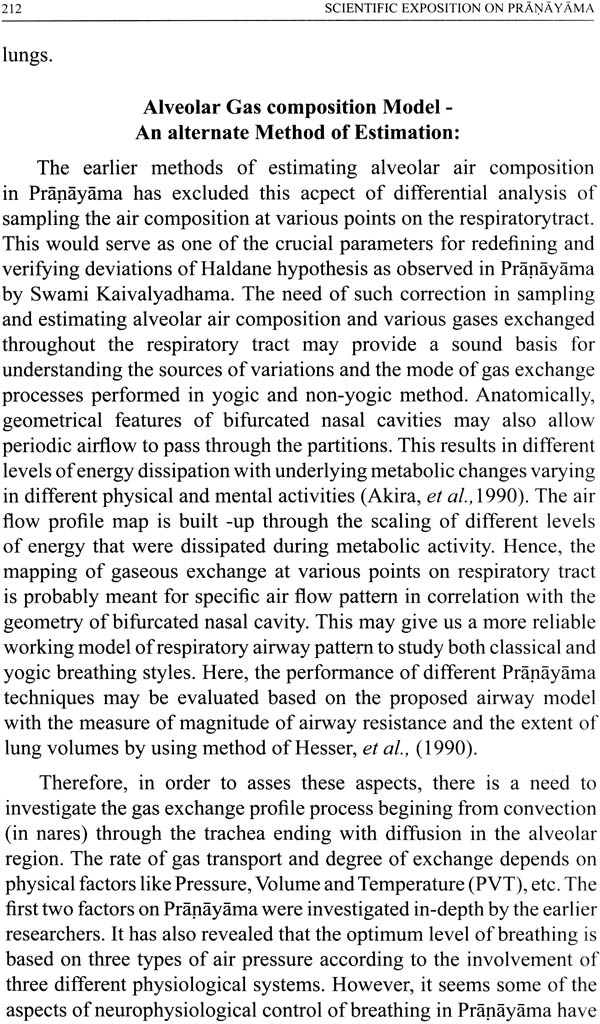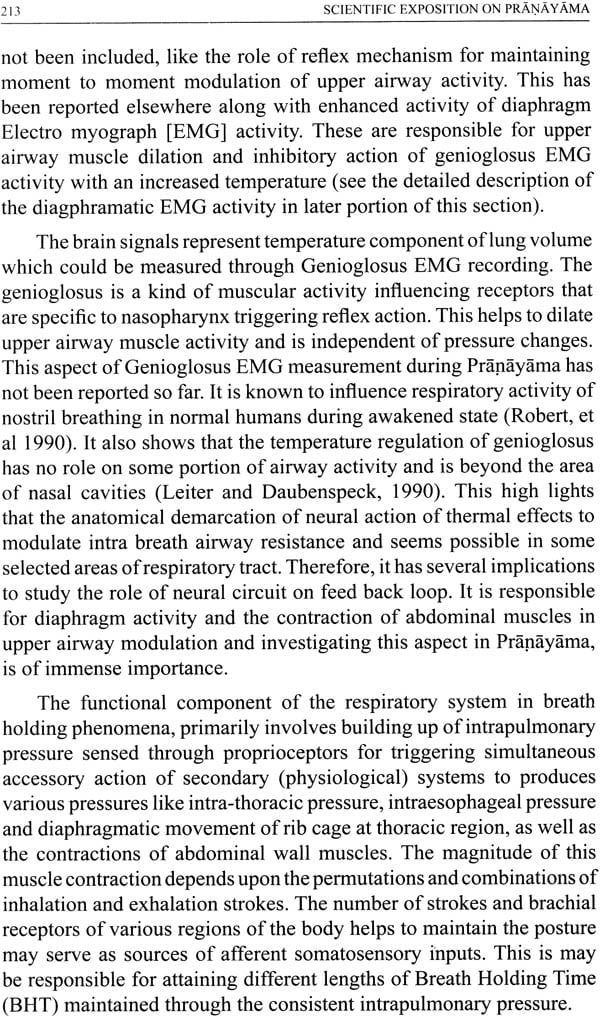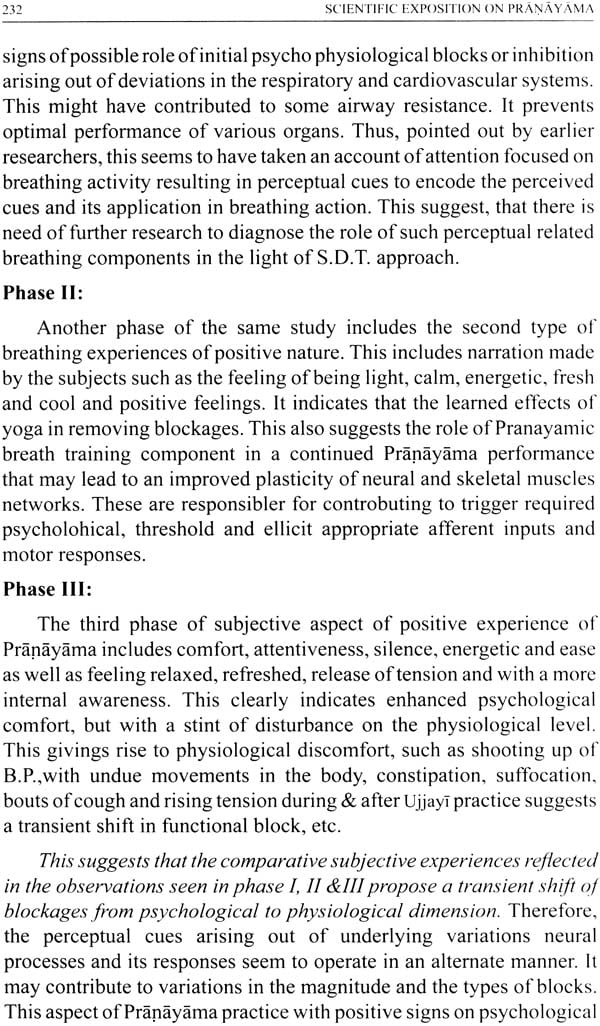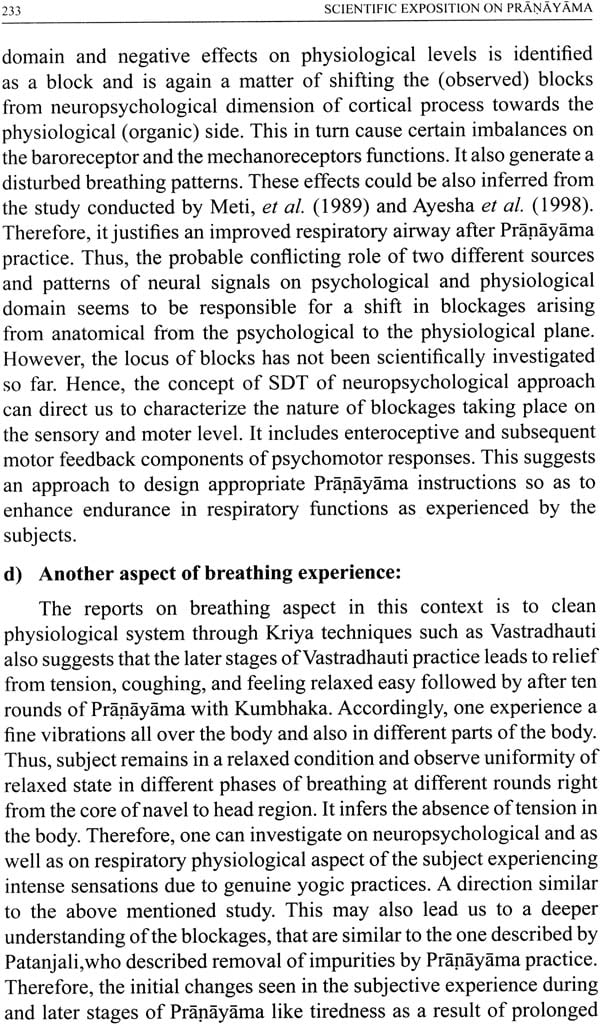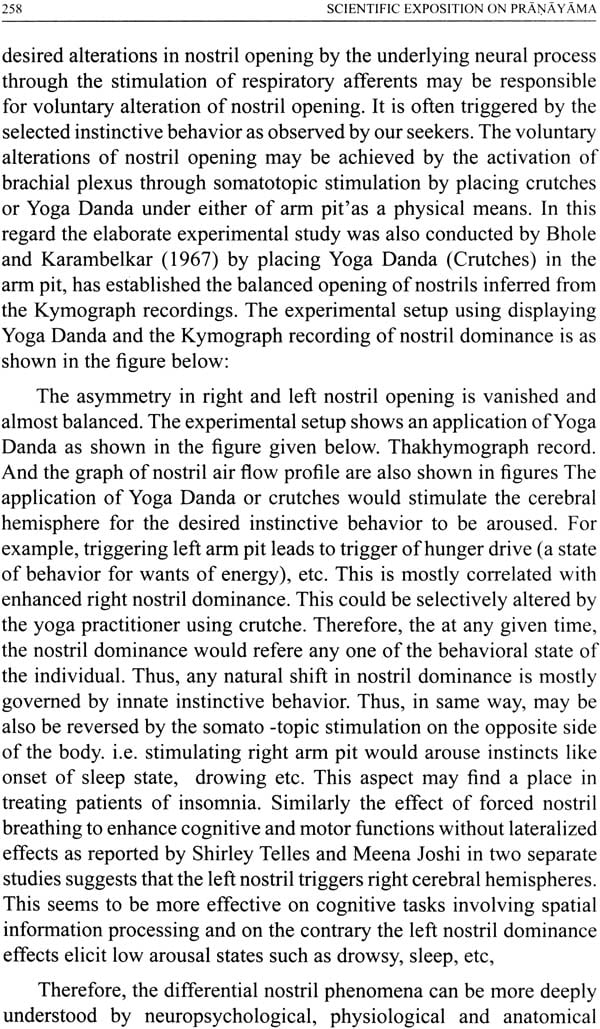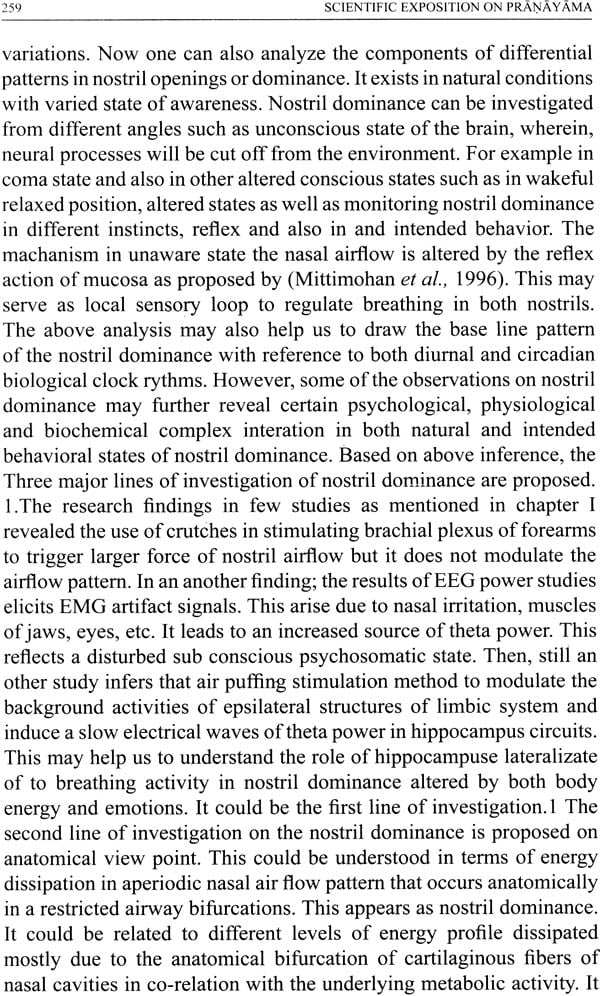
Scientific Exposition on Pranayama - A Review
Book Specification
| Item Code: | NAH028 |
| Author: | Swami Maheshananda and D.D. Kulkarni |
| Publisher: | Kaivalyadhama Samiti Lonavla |
| Language: | English |
| Edition: | 2012 |
| Pages: | 274 |
| Cover: | Paperback |
| Other Details | 8.5 inch X 5.5 inch |
| Weight | 350 gm |
Book Description
“This is a marvelous piece of review work that enlightens the scientists /research scholars, medical and paramedical professionals especially who are actively engaged in probing the effect of Pranayama from view point of neuro-psycho-physiology and specifically respiratory and pulmonary physiological areas of research. This is the first attempt in the field of scientific research in yoga and yogic science at large to corroborate the subjective experience within the frame of modern science…”
Pranayama an ancient Indian traditional art of Breathing and Breath - control, is one of the eight limbs of Astanga Yoga formulated by Patanjali Muni. This is a marvelous piece of review work that enlightens the scientists /research scholars, medical and paramedical professionals especially who are actively engaged in probing the effect of Pranayama from view point of neuro-psycho-physiology and specifically respiratory and pulmonary physiological areas of research. This is the first attempt in the field of scientific research in yoga and yogic science at large to corroborate the subjective experience within the frame of modern science. His work will also guide the researcher to evolve a full proof research project that can be meticulously handled through the delicate and subtle issues of psycho-physiological processes towards transparency across subjective experience and the objective measures. This will provide scientific acceptance to treat the Pranayama as a Science of Breath on an equal footing like any other respiratory phenomena but with an exception. This work will also cover the lacunae observed in the past research works and paves the way to develop newer understanding of complex psycho-physiological mechanisms and effects of Pranayama from cortical information processing view point and will be beneficial to the scientists who are actively engaged in the Pranayama research at large. Therefore, this piece of information brought out in the form of a book, I am sure, that the ideas and suggestions expressed would give a tremendous impact towards developing a quality based scientific research in Pranayama with a complete scientific acceptance at par with other fundamental and applied clinical sciences within scientific community and may also contribute as a useful research tool for research related issues in health sciences.
This is a matter of great satisfaction that our Scientific Research Department is expanding the horizon of scientific knowledge of yoga inspired by the works of Swami Kuvalayananda, the founder Director of Kaivalyadhama that has encouraged us to explore the future arenas in Pranayama research. The idea to prepare this work:- “Scientific Exposition on Pranayama – A review” flashed in our minds in the year 2005, with an inquisitive interest to find out the scientific outlook of Pranayama research both on quantity and quality covered so far by various laboratories. This aspect of growing interest among research workers to conduct research in Pranayama is evident from the past scientific research works reported in various journals. After going through the articles and a brief discussion on them by present authors, it was inferred that there were no tangible research results with reference to the Pranayama effects reported from different laboratories. This aspect has motivated the authors to scrutinize the past research reports that lead to brain storming ideas in developing a comprehensive quality based technical hand book useful for researchers. The beginning of research work started from our i.e. Kaivalyadham Laboratory. Ours is the premier research institute and as all of us are aware that Swami Kuvalayanandas’ vision of scientific research in yoga originated way back in 1920. Hence the Pranayama research work covering more than six decades were reviewed from the compiled work of yoga mimamsa publications and the proceedings of three international conferences as well as other various scientific journals reporting the Pranayama research work by various institutions. This has prompted the authors to evaluate the past research work and wish to suggest better standard of research with interdisciplinary approach and also to treat Pranayama as subject of scientific research problem both on fundamental and applied science as well as gaining acceptance with a scientific research on Pranayama includes both traditional and contemporary yoga institutes; such as Kaivalyadhama Lonavala since 1920 followed by other yoga institutions like Yoga institute of Santa Cruz (Mumbai), Vivekananda Kendra (Bangalore), Bihar School of Yoga (Munger), Vemana Yoga Institute (Hyderabad) as well as various medical colleges and universities across the globe. This emerging research field on Pranayama has begun to impress scientists, physical educationists, doctors and experts of medical and paramedical fraternity with specialized and diversified academic interests.
According to modern medical science, the Pranayama is a complex psycho-physiological process of breathing, although, subjective experience is well admitted as the tested belief among the sincere Pranayama practitioners. But when it comes to the matter of scientific scrutiny, it becomes intangible to account for the observed changes in the body and mind. Therefore, this work will address the basic research issues which are scientifically compatible to deal with the various types of Pranayama techniques and accordingly tested by various laboratories that has lead to inadequacies in their research findings. Besides this, it has its own limitations being viewed as water tight compartment leading to the intangible conclusions as observed from survey study in first chapter of this book. The second chapter of this work focuses on the interdisciplinary research and better networking of the principles of interdisciplinary approach of science towards comprehensive understanding. Therefore, this research view expressed in this book will be helpful for the neuropsychologists, psychologists, physiologists and biochemists to counter-check their research findings/ inferences on Pranayama effects and also adopting the research ideas.
The new methodologies expressed in this book applied will be helpful to design an effective research model of Pranayama in the field of various human performance such as sports, defense, education and therapy to understand the pharmaco-dynamics of Pranayama.
In conclusion, we express our sincere gratitude towards all the members of Kaivalyadhama Pariwar for their direct and indirect contribution towards this work.
The Pranayama occupies the fourth position in the Scheme of Ashtanga yoga of Patanjali and deals with the very fabric of the existence of life which is referred to as vital energy or Prana. The Hatha yoga mentions that practice of yogic methods like Pranayama, Bandha, Mahamudra and Kriya cure all the diseases both of acute and chronic types as quoted in the verse H.P.: 3.1,6; 3.7; 2.16 (Digamberji & Kokaje, 1970). However, the term Prana is a breathing phenomenon in a true physical sense. The scientific community and medical fraternity recognizes only two facets of respiration i.e. normal and pathological. The Pranayama according to the tested belief based on the traditional claims may be defined conveniently based on psycho physiological principles as a breathing technique equated to applied technique of respiration. Since, performing voluntary breathing and its physiological effects taking place at various physiological and cellular level are mostly attributed to the metabolic changes. On the contrary, the neurophysiologists propose the Prana as the carrier of nerve impulse being modulated by the brain to drive all the other systems. This serve as the logistic units for survival of various body organs through regulating metabolic activity of the body.
Therefore, according to the neuro-psychology, the typical breathing with or without effort involves higher brain functions to modulate neuro-muscular system as logistic purposes both on system and at cellular level targeting to activate and mobilize all the necessary physiological systems; such as respiratory, circulatory, cardiovascular and excretory systems for an efficient and economical mode of transporting metabolites and waste products, such as O2' CO2, NO gases, metabolites like glucose, fat and ions like Na+, Ktc ions as well as glandular secretions include insulin, bile juice, etc. Besides, this activating various enzymes like ATPase, Phosphokinases, etc., towards the completion of optimum metabolism at cellular level. However, on the contrary, Swamijis' preliminary research findings revealed that the Pranayama leads to reduced oxygen consumption and high CO2 tolerance. This suggests a unique yogic objective towards art of managing metabolic resource allocation despite the physiological efforts apparently same as in any physical stress.
This aspect of Prana entity may serve as an essential fabric of existence and as a crossroad to sustain the vegetative existence. The autonomic functions that regulate all the physiological systems required in survival process are at the cost of entire metabolic output power; such as energy required for skeleto-muscular cells to enhance pumping ability of the cardio-vascular functions, capacity of blood flow constituents to support metabolism forming a close feedback loop, etc. This will be ultimately concerned to support the existence of billions of cells. However, even a slight alteration in these logistic supporting systems initiated by the brain cells may cause ripple effects on overall cell functions either at gross or subtle level. Therefore, the vast number of scientific research on Pranayama as reported in chapter one nevertheless provide some clarity on psycho- physiological ripple effects of Pranayama on various systems such as physiological, biochemical, etc. affecting both on physical and mental plane. However, few other unresolved aspects form the grey areas have never been explored so far.
This work address ample of lacunae on blunt approach to assess the global effects of Pranayarna technique performance with regard to evaluation. This reflects the lack of integrity to network the scientific information extracted from various disciplines of different nature such as fundamental, applied, therapeutical applications which could be of theoretical or experimental nature of importance, whose results and inferences are gathered from work done by different investigators on various aspects of Pranayama techniques, from which the conclusion drawn may remain intangible. This scientific illustration of Pranayama effects on vital organs; such as heart, kidney, liver, excretory, genital, higher brain and entire nervous systems by adopting different research methodologies are critically evaluated.
Based on such outcome, the authors in the second chapter have pointed out an unique ability of the brain to estimate breathing pattern, its reproducibility in terms of ratio, frequency, intensity and duration as well as to achieve the intended nature of subjective experiences, etc. This would characterize various types of Pranayamas apart from conventional breathing techniques. The Pranayama types such as Ujjayi Pranayama performed with a specific purpose involving (breath hold) Kumbhaka and other techniques such as Bhastrika, Kapalabhati which are high frequency breathing technique without breath hold are meant for cleansing respiratory airways to remove impurities in the respiratory airways as per the description in chapter II of Hathapradipika, but yet it is classified as type of Pranayama although it is solely meant for purification of respiratory function. Therefore, through this purification technique, one can enhance system efficiency leading to decreased physiological resistance in realizing few yoga effects such as conserving biological energy to certain extent. Similarly, on the other hand the Anuloma- Viloma which is a simple, shallow, effortless breathing process without Kumbhaka is considered as an accessory aspect of purification process of psychophysiological energy channels or as Nadisuddhi. Besides, this, still other varieties of non Pranayama breathing techniques involving oral cavity and vocal cord; such as practicing Sitali, Sitkari and Bhramari Pranayama serves varieties of psycho-physiological benefits. This suggests a multi varied purpose of Pranayama breathing techniques.
The authors review is based on three types of knowledge sources to deal about this vast topic. This includes interpretation of experiential aspect of Pranayama effects based on Traditional and textual descriptions supported by various hypothetical associated concepts like Panca Maha-Bhutas, Prakriti, Panchakosha, Purusha, etc. The second angle of interpretations is based on outcome of seminars, workshops, discourses with reference to traditional descriptions of Pranayama and finally the third angle of exploring Pranayarna topic is the scientific interpretation based on the past research work. This is of immense importance to begin the present work. Therefore, the main feature of this work is dedicated to the scientific interpretation of Pranayama research studies.
Based on the scientific approach experimental research work of Pranayama, the survey reports in this book one has led to explore the possible projection about a complete picture of Pranayama process and its effects in a new direction based on the scientific facts of the past study. The ideas are based on the concepts of the advanced fundamental psycho- physiological studies. If some of these advanced physiological ideas are fitted into the background of the past research findings, this would certainly lead to the extrapolation of the inferences predicting an integrated and tangible effects. Therefore, one can network the research inferences drawn from various disciplines to draw a comprehensive conclusion and may be an eye opener and also a powerful tool to visualize the global effects of Pranayama, This could be justified as an applied breathing technique. Hence, in this book this aspect may provide suitable solution to design and to execute new research methodologies in Pranayama research. This book has two chapters. The chapter I encompasses scientific research data base and chapter II encompasses the interpretations, new concepts, suggestions, etc.
In future, it will be possible to compile the pranayamic psychophysiological data for objective quantification along with qualitative analysis to describe the experiences in Pranayama as based on the traditional text. This forms the scientific source material. The present source material is the practice knowledge realized as per the Yogic text. However, in the scientific study, the several difficulties arising in the scientific yogic research field to investigate Pranayama experiences are due to various reasons. 1) The non-availability of genuine and long term Pranayama practitioners on large samples, 2) To maintain controlled mental state, 3) The efficacy & quality of scientific investigation at various levels such as a) Testing the effects of experience and its results on gross level, b) Effects from gross to subtle level. c) To investigate real and original cause of life. d) Difficulties to accept the scientific limitations. etc. However, the essence of cause of life lies even beyond the organic existence. Therefore, to overcome this barrier the need is to find an appropriate scientific terms and concepts which are equivalent to Yogic terminologies and concepts, such as Prana, Vayu, etc. Thus, there are various unprovable yogic concepts which are difficult to investigate with scientific approach. For example Akash, Vayu, Jala, Agni, etc.
| Introduction | 12 |
| Chapter I | 17 |
| Part A: Survey work | |
| Survey done on Pranayama Research Work (General) | 23 |
| Part B: Past Research Details | 24 |
| Part C:- Detailed Research work of Swami Kuvalayananda | |
| Section 1: Pranayama Technique Details and Objectives | 34 |
| Section 2: Research detail includes: hypothesis, methodology, results inferences and conclusion | 38 |
| Section 3: Theme of the Discussion and Conclusion of the study | 82 |
| Section 4: Detailed Results | 84 |
| Part D: Detailed Research work done by Staff of Scientific Research Department, Kaivalyadhama | |
| Section 1: Pranayama Technique Details and Objectives | 86 |
| Section 2: Research Details | 104 |
| Section 3: References Discussion and Conclusion. | 170 |
| Section 4: Detailed Results | 186 |
| Chapter II | |
| Introduction | 203 |
| A Revisit to Basics of Breathing | 207 |
| The Respiratory Airway Model | 211 |
| Defining Grey Areas in Pranayama | 214 |
| The Future Trends in Research Methodology | 220 |
| The Basics of Breathing Pattern | 256 |
| The Hypothalamus in Nostril Dominance | 260 |
| Conclusion | 262 |
| Recommendation | 263 |
| Appendix | |
| References | 265 |
| Special references | 271 |
| Glossary | 272 |
| Subject Index | 274 |
